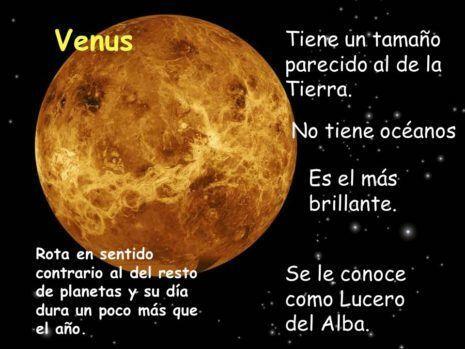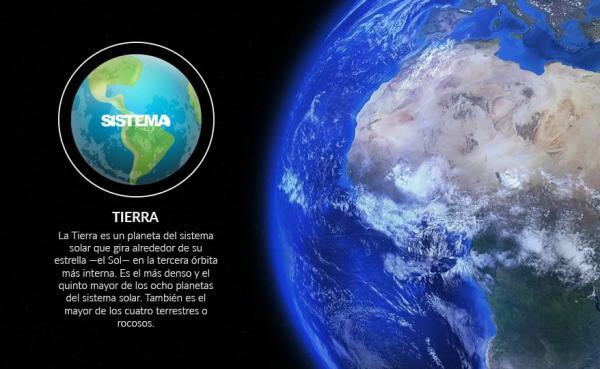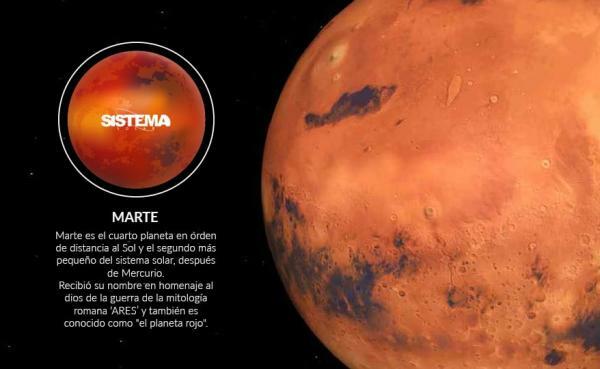INNER planets of the Solar System

The four inner planets of the Solar System are called rocky or terrestrial planets and are: Mercury, Venus, Earth and Mars. In this lesson from a PROFESSOR we will tell you what are the common characteristics of the inner planets of the solar system and what are the particularities of each one of them.
Index
- Characteristics of the inner planets of the solar system
- Mercury
- Venus, another of the inner planets
- The earth
- Mars
Characteristics of the inner planets of the solar system.
The inner planets of the solar system are those that are found closer to the Sun, specifically between the Sun and the main asteroid belt. They are a total of four planets; Mercury, Venus, Earth and Mars. These planets not only have in common their location in the innermost area of the Solar system, rather they have a number of common characteristics:
- They are called terrestrial or rocky planets because they all have one solid and compact surface.
- His size is small in comparison with the planets of the outer solar system (those furthest from the Sun), which are called gas giants.
- They turn on themselves slowly, that is, they have a relatively low rotational speed.
- All terrestrial planets have a metal core, fully or partially melted. Above the core is a molten rock mantle in motion due to the internal heat of the core, and, above this, there is a solid crust.
- Have few or no moons (natural satellites): Mars has two moons, Earth has one, and Venus and Mercury have no moons. They also don't have ring systems as it happens in the case of gaseous planets.
- Unlike the gaseous planets, the terrestrial planets nor have magnetosphere (magnetic field) or is this relatively weak.
- All the inner planets of the solar system with the Mercury exception, they have one gaseous atmosphere.
- In recent years it has been shown that on all terrestrial planets there is volcanic activity.
Mercury.
It is the smallest of all the planets in the solar system and the closest to the Sun. It is slightly larger than our moon. Mercury has no atmosphere and for this reason, on its surface the temperatures are extreme, since, despite being very close to the Sun, it does not retain heat at night. Daytime temperatures can reach 470ºC and descend overnight for up to -180ºC.
The core of Mercury is Large size, with a radius that represents 85% of the planet's radius. While the layer formed by the mantle and the crust it is very thin, with a thickness of about 400 kilometers.
Its surface is characterized by the presence of large craters formed by the impact of meteorites or comets, and also due to the volcanic activity of the planet. It is believed that there could be water at the poles of the planet, inside large craters in areas that are always in the shade.
Despite not having an atmosphere, Mercury has a exosphere, composed of a thin layer of gases from the solar wind and particles torn from the surface of the planet. Is composed of oxygen, sodium, hydrogen, helium and potassium.
His magnetic field is very weak, only 1% of the force of the Earth and is displaced with respect to its axis.

Venus, another of the inner planets.
Venus it is similar to Earth in structure and size. However, in many respects they are totally different. It is the second planet in the solar system closest to the Sun, but despite the fact that Mercury is closest to the Sun, Venus is the hottest planet of the solar system, with surface temperatures reaching 741ºC.
The high temperatures of Venus are due to the presence of a atmosphere dense composed of carbon dioxide, a gas with greenhouse effect that traps heat from the Sun, retaining it in its atmosphere. The atmosphere of Venus also contains clouds formed by drops of sulfuric acid, which are dragged by hurricane-force winds of 360 km / h.
The atmosphere of Venus is made up of different layers at different temperatures. About 30 kilometers from the surface, where sulfuric acid clouds are found, the temperature is similar to that of the Earth's surface. The dense atmosphere of Venus is also responsible for the high pressures on the planet's surface, more than 90 times higher than Earth's.
It is a planet whose motion of rotation goes from East to West, in reverse to the rest of the planets of the solar system (with the exception of Uranus). The internal structure of the planet is very similar to that of the Earth, with a nucleus of similar size. However, the magnetosphere of Venus is much more weak, due to the slow rotation speed of the planet.
On the surface of Venus there are mountains, valleys, and thousands of volcanoes. The high volcanic activity of the planet totally transformed the planet's surface in the past (between 300 and 500 million years ago).
Furthermore, the surface of Venus has a large number of craters large, caused by the impact of large meteorites. Smaller meteorites fail to hit the surface of Venus because they burn in its dense atmosphere and are destroyed before reaching the surface. The presence of water has not been detected on Venus.

The earth.
Our planet is the third closest in the solar system to the Sun and the biggest of the four planets of the inner solar system. Slightly larger in size than Venus, it is the only planet in the solar system with liquid water on its surface. The bodies of water cover the 70% of the surface of the planet.
The surface of the earthit has volcanoes, valleys and mountains just like Venus and Mars. His Cortex this divided into plates (the tectonic plates) that are in constant motion floating on the molten rock mantle. Most of the terrestrial volcanoes are in the depths of the oceans like the main mountain ranges and the highest mountains.
The atmosphere of the Earth is composed of a 78% nitrogen, 21% from oxygen and 1% of other gases. This atmosphere protects the planet's surface from harmful radiation from the Sun and from the impact of meteorites. Has a magnetosphere more stronger than the remaining inner planets due to two factors: its relatively fast rotation speed and its metallic core composed of iron and nickel. When electrically charged particles from the solar wind are trapped by the magnetic field at the planet's poles; collide with molecules in the atmosphere and these emit light giving rise to Aurora borealis.
Earth is one of the two inner planets that has moons. Actually, it is the only planet that has a single moon. The only moon on Earth is the fifth largest of the moons in the solar system and revolves around our planet. at a distance of about 385,000 km.
The presence of the Moon orbiting our planet stabilizes the axis of rotation of the Earth, which would otherwise suffer chaotic alterations over time, causing climatic changes that would have hampered the development of life on the planet. Therefore, the presence of the natural satellite (Moon) is one of the factors that made possible the appearance of life on Earth.

Image: The Solar System
Mars.
Mars is the inner planet furthest from the Sun, its size it's almost the half that of the Earth and owns a thin atmosphere. It's a planet very dynamic with stations, polar caps and extinct volcanoes, which bear witness to its even more dynamic past. It is one of the most explored celestial bodies in the solar system, and the only one where space vehicles have been sent to study its surface.
The crust of the planet is made up of iron, magnesium, aluminum, calcium and potassium; and is between 10 and 50 km thick. The iron minerals present on its surface give it a reddish coloration, for this reason, Mars is also known as the Red planet.
His thin atmosphere is made up of carbon dioxide, nitrogen and argon and it does not offer protection against the impact of meteorites. Occasionally winds strong enough to create dust storms, which affect the entire planet. The dust is suspended for months in the atmosphere until it is re-deposited on the surface.
The temperature on the surface of Mars oscillates between 20ºC and -153ºC. These large fluctuations in temperature are explained by the fact that the thin atmosphere of Mars is unable to retain the heat that reaches it from the Sun, so that it dissipates very quickly.
Its axis of rotation has an inclination very similar to that of the Earth and for this reason, it also there are seasons throughout the year (period of translation) on Mars. Due to the elliptical orbit of Mars, each of the seasons has a different duration, unlike what happens on Earth where the four seasons of the year last three months each.
Currently, Mars has no magnetosphere, but some areas of its southern hemisphere are strongly magnetized, indicating the existence of a magnetic field in the past. Dust storms, crustal movements, volcanic activity, and meteorite impacts make the surface of mars present a large number of topographic features of interest such as:
- The great Martian cannon named Valles Marineris (Sailor's Valley) and that is ten times larger than the Grand Canyon of the Colorado.
- The Mount Olympus, which is the largest extinct volcano in the entire solar system, with a height three times that of Mount Everest on Earth.
Mars seems to have contained abundant water in the past, since river basins, deltas and lake beds are observed on its surface (such as that of the crater Jezero whose surface the Perseverance vehicle explores to try to find remains of life there microbial). Minerals and rocks are also found on its surface that could only be formed in the presence of water. Currently, Mars contains water under the surface of polar ice caps in form of ice, in addition to saltwater It flows down mountain slopes and crater walls periodically.
Moons of mars
Mars possesses two moons:Deimos and Phobos, which are among the smallest in the solar system. It is one of the darkest objects in the solar system and is believed to be composed of rocks rich in carbon and ice.
Phobos is a bit bigger than Deimos and its orbit is the closest to a planet known (only 6000 km away from the planet's surface). Viewed from Mars, Phobos occupies much of the sky. Deimos' orbit is further away. Like Earth's Moon, the two moons of Mars always have the same face facing the planet.

Image: The Solar System
If you want to read more articles similar to Inner planets of the Solar System, we recommend that you enter our category of Astronomy.
Bibliography
- Scott L. Murchie, Ronald J. Vervack Jr, Brian J. Anderson. (2011) Travel to the planet closest to the Sun. Astrophysics. Research and Science. Barcelona: Scientific Press S.L
- S.L. Shannon Hell (2020). The transformation of Venus. Planets Research and Science. Barcelona: Scientific Press S.L.
- Arden L. Albee. (2003) .Mars, a singular planet. Astronomy. Research and Science. Barcelona: Scientific Press S.L.
- Jacques Laskar (1994). The Moon and the origin of man. Astronomy. Research and Science. Barcelona: Scientific Press S.L.



